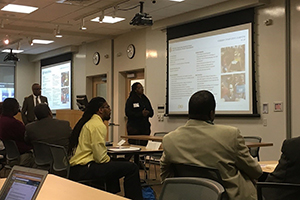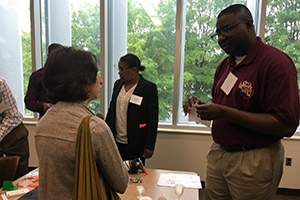14 Sep2017
By Aaron Goldstein

This week, the Council of Chief State School Officers (CCSSO) released Transforming Educator Preparation: Lessons Learned From Leading States, a playbook for how states can improve educator preparation based on the experience of the Network for Transforming Educator Preparation (NTEP).
States that participated in NTEP – a multiyear effort to identify policies that effectively support the preparation of profession-ready teachers – were California, Connecticut, Delaware, Georgia, Idaho, Kentucky, Louisiana, Massachusetts, Missouri, New Hampshire, Oklahoma, South Carolina, Tennessee, Utah, and Washington.
11 Sep2017
By Aaron Goldstein
 Last month, AACTE staff hosted an exhibit at the National Conference of State Legislators (NCSL) Legislative Summit in Boston, Massachusetts. We also invited leaders of the local AACTE state chapter, the Massachusetts Association of Colleges for Teacher Education (MACTE), to join us in the exhibit booth to share their work with attendees. Over 5,000 state legislators, state legislative staff, and trade association representatives attended the conference.
Last month, AACTE staff hosted an exhibit at the National Conference of State Legislators (NCSL) Legislative Summit in Boston, Massachusetts. We also invited leaders of the local AACTE state chapter, the Massachusetts Association of Colleges for Teacher Education (MACTE), to join us in the exhibit booth to share their work with attendees. Over 5,000 state legislators, state legislative staff, and trade association representatives attended the conference.
As I learned from last year’s NCSL Legislative Summit (see my takeaways here), state legislators are eager to receive input from teacher educators. One recurring theme from my conversations with state legislators this year was that they are unfamiliar with the major state policy levers pertaining to educator preparation – accreditation, licensure, and program approval. It was good for AACTE staff and MACTE leaders to interact with attendees from dozens of states, including many members of state legislatures’ education committees.
05 Sep2017
By Amy Vessel
This article is the last in a series of three showcasing the transformation of preservice field experiences at Louisiana Tech University. Read the first article here and the second here. The views expressed in this post do not necessarily reflect the views of AACTE.
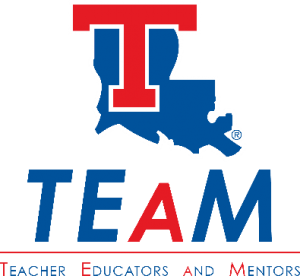
In a traditional student teaching experience, the school and mentor agree to host a teacher candidate in the classroom for 10-15 weeks, which can be viewed as a short-term accommodation that is not integral to the school community. In a full-year clinical residency, however, the importance of the mentor-resident placement is essential to the success of the school year for all involved. Therefore, the TEAM (Teacher Educators and Mentors) Model Clinical Residency Center at Louisiana Tech University has made the design of a quality placement procedure a priority.
In the TEAM Model timeline, residents and mentors apply in April/May to participate in the full-year clinical residency. Upon university, school, and district approval of the participants, an electronic clinical styles inventory is distributed to all participants in late May/June, and all placements are finalized in July. On the online inventory, mentors and residents rate their own traits around personality, planning, teaching, professionalism, and other areas in order to better identify their clinical style.
30 Aug2017
By Aaron Goldstein

Seven state chapters of AACTE will share $50,000 in funding from the 2017 State Chapter Support Grant competition.
AACTE is pleased to support these state chapters as they develop new initiatives and projects focused on advocacy, program quality, and chapter development. For the 6th year, these grants will help strengthen AACTE’s relationship with our state chapters.
29 Aug2017
By Cole Dittmer
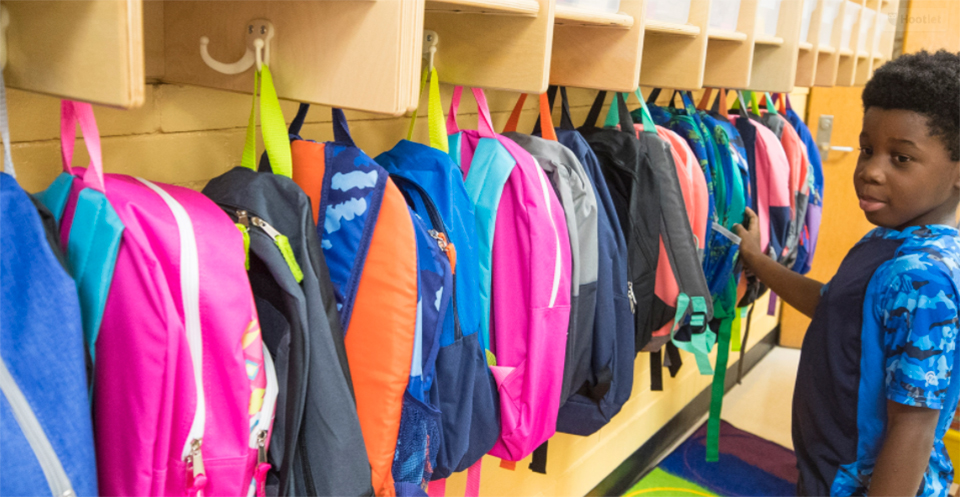
This article, originally published here, is reposted with permission from the East Carolina University News Services.
East Carolina University’s youngest students got their first look inside the ECU Lab School during open house on Aug. 24.
“I love it, everything,” exclaimed fourth-grader Breanna Daniels after seeing her new classroom.
22 Aug2017
By Amy Vessel

This article is the second in a series of three showcasing the transformation of preservice field experiences at Louisiana Tech University. The views expressed in this post do not necessarily reflect the views of AACTE.
In fall 2016, Louisiana Tech University’s Clinical Residency Center established an 8-year partnership with the Louisiana Tech Athletics Council to collaboratively mentor students in TEAM (Teacher Educators and Mentors) Model schools, strengthening connections between the university and the community while exposing more college students to the teaching profession.
The program started after head men’s basketball coach Eric Konkol began seeking ways to plug his team into the community, followed very quickly by head baseball coach Lane Burroughs. The coaches had the desire to increase their teams’ connections with area schools and sought the expertise of the College of Education to establish quality partnerships.
To meet this goal, we developed the “Dogs With a Cause” program, which pairs athlete mentors with elementary students in a character-building literacy curriculum based on award-winning children’s books. This program is a logical extension of our TEAM Model, which engages multiple schools and districts in collaborative partnerships that support a full-year residency for teacher candidates.
15 Aug2017
By Michael Maher

The views expressed in this post do not necessarily reflect the views of AACTE.
The Legislative Long Session in North Carolina this year was, in many ways, a productive one for education, generating a number of consequential bills that became law. Included in the slate was the reintroduction of the Teaching Fellows program, thanks to a collaborative effort led by Senator Chad Barefoot and the North Carolina Association of Colleges and Teacher Educators (NCACTE).
08 Aug2017
By Jason Wingate
The author is a member of AACTE’s Clinical Practice Commission. The views expressed in this post do not necessarily reflect the views of AACTE.
During the recent accreditation visit on my campus, my colleagues and I encountered the comprehensiveness of the new Council for the Accreditation of Educator Preparation (CAEP) standards and how difficult it is to reach those standards entirely, especially in a state that does not share PK-12 data of students and graduates. In one area, however, we thrived: Standard 2, which focuses on clinical partnerships and practice.
07 Aug2017
By Amy Vessel

This article is the first in a series of three showcasing the transformation of preservice field experiences at Louisiana Tech University. The views expressed in this post do not necessarily reflect the views of AACTE.
With a vision of quality, rich field experiences connected to theory and practice for many years, Louisiana Tech University was well positioned to chart a path in the early years of Louisiana’s Believe and Prepare initiative to transform traditional student teaching to a full-year clinical residency. Already, the redesigned model is having a positive impact on teacher preparation and engagement, not only in our programs but throughout the state.
18 Jul2017
By Kristin McCabe

Thanks to several brand-new sessions and revamped activities throughout the original program, next month’s regional AACTE Quality Support Workshop will deliver an even more robust program than its popular predecessor. During the event August 10-12 in Minneapolis, Minnesota, participants will choose from two dozen expert-facilitated workshops offered in seven time blocks – with topics such as interpreting candidate assessment data, mapping curricula to competency indicators, preparing evidence for an accreditation visit, recruiting and supporting more diverse candidates, and others.
Many of the sessions from last spring’s southern regional workshop, held in Fort Worth, Texas, will run again in Minneapolis with few changes. Others are bringing in new facilitators or making adjustments to reflect feedback from attendees (the organizers do try to practice what they preach about using data for improvement!).
10 Jul2017
By Aaron Goldstein

On behalf of AACTE, I recently attended the annual National Forum on Education Policy of the Education Commission of the States (ECS), a national organization of state education policy leaders. The more than 550 attendees at the forum included governors, state education chiefs, chairs of state legislatures’ education committees, and higher education executives, many of whom were new to their position. In fact, one of my main takeaways from the conference was the high level of recent turnover in states’ positions for education decision makers – and the associated need for educators to maintain outreach efforts to connect with them.
Over the past 2 years, there has been drastic leadership change for state legislators, chief state school officers, and governors. In 2016, elections were held for 86 of the 98 partisan state legislative chambers and for 6 of the 13 elected chief state school officers. Furthermore, the average tenure of a chief state school officer is approximately 2½ years. In 2017, 36 states will hold elections for their governors, at least 16 of which must be new due to term limits.
27 Jun2017
By Amanda Lester

On July 27, AACTE will host the final installment of a four-part webinar series highlighting the experiences and findings of each of the 10 institutions in the AACTE Black and Hispanic/Latino Male Teachers Initiative Networked Improvement Community (NIC). The webinar, “Diversifying the Teacher Pipeline at CSU-Fullerton and Northeastern Illinois University: Lessons From AACTE’s NIC,” will be held on Thursday, July 27, 2:00-3:00 p.m. EDT.
In this webinar, presenters from California State University, Fullerton, and Northeastern Illinois University will discuss the how their teams applied improvement science in the context of the NIC, as well as at their own institutions. The discussion will feature specific initiatives and strategies developed by both institutions’ teams and will demonstrate how NIC-developed approaches can be adapted locally to advance a common goal – in this case, to increase the percentage of Black and Hispanic/Latino men receiving initial teaching certification through educator preparation programs.
27 Jun2017
By Shawn Karim
Two final videos are available this week on AACTE’s Research-to-Practice Spotlight Series highlighting the St. John’s University (NY) School of Education clinical preparation program known as RISE. These videos focus on building successful collaborations among professors, future teachers, and schools, and on important themes such as flexibility, humility, and remembering the “bottom line” goal of helping children learn.
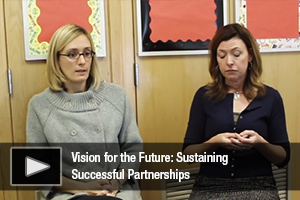
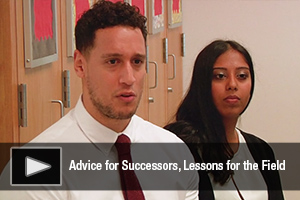
20 Jun2017
By Amanda Lester
A member of the North Carolina A&T State University team shares its work during the May event at Morgan State University.
Abiodun Fasoro of Central State University discusses his campus’ minority male STEM program during the Verizon Innovative Learning Showcase.
Last month, I had the privilege of participating in the Building a Networked Improvement Community Around Engaging Minority Males in STEM Workshop at Morgan State University. The workshop focused on advancing the work of the Early STEM Engagement for Minority Males (eSEM) Initiative, a network of 16 minority-serving institutions (MSIs).
Led by Morgan State and in partnership with Verizon Innovative Learning Programs, SRI Education, the National CARES Mentoring Network, and local school districts, eSEM is a growing collaborative seeking to address STEM achievement challenges and improve outcomes for middle school minority male students through the development of a Networked Improvement Community (NIC). The initiative is supported through grants from the National Science Foundation and includes the following universities:
13 Jun2017
By Kristin McCabe
Two new videos are available this week on AACTE’s Research-to-Practice Spotlight Series highlighting the St. John’s University (NY) School of Education clinical preparation program known as RISE, or the Residential Internship for St. John’s Educators. This week’s video interviews present faculty and administrators discussing various challenges they’ve had to overcome in setting up and sustaining the RISE Program – and why the results are worth the effort.
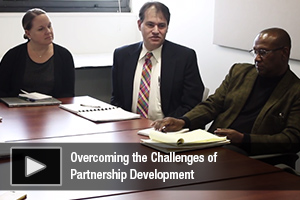

The School of Education at St. John’s University (SJU) and its Residential Internship for St. John’s Educators (RISE) have hit a stride with their clinical partnerships to prepare new teachers – but it wasn’t always easy. To get to this point, all parties have worked to overcome hurdles and cultivate strong relationships that set them up for successful navigation of future bumps in the road.








 Last month, AACTE staff hosted an exhibit at the
Last month, AACTE staff hosted an exhibit at the 










